#workforce adaptation
Explore tagged Tumblr posts
Text
The Ethics of Artificial Intelligence: Balancing Progress and Privacy
Artificial intelligence (AI) has rapidly become an integral part of our lives, revolutionizing industries and streamlining various aspects of our daily routines. From virtual assistants like Siri and Alexa to AI-powered customer support, the applications of AI are ever-expanding. However, as AI continues to make strides, concerns about its ethical implications are also on the rise. Balancing the…

View On WordPress
#AI accountability#AI ethics#AI regulation#algorithmic bias#data privacy#explainable AI#job displacement#privacy protection#responsible AI#workforce adaptation
0 notes
Text

Learn how TruFynd’s innovative workforce solutions help businesses achieve agility and efficiency through flexible hiring models. Explore the benefits and strategies to stay ahead in a dynamic market.
#flexible hiring#TruFynd#workforce solutions#adaptive workforce#modern recruitment#cost-effective staffing#scalable hiring strategies
0 notes
Text
Healthcare facilities often experience surges in patient care needs due to seasonal fluctuations, unexpected absences, or growing patient demands. During these times, partnering with staffing agencies becomes crucial to maintaining quality care without disruption.
0 notes
Text
0 notes
Text
Embracing the Hybrid Work Model: Navigating the New Normal
As we stride into a post-pandemic world, organizations worldwide grapple with a novel challenge: transitioning from crisis-induced remote work to a more sustainable, long-term solution. At the heart of this transition lies the hybrid work model – a blend of remote and in-office work.As an HR professional, it’s essential to understand this model’s nuances, its advantages, challenges, and how we can effectively implement it.
Understanding the Hybrid Work Model
The hybrid work model is, in essence, a flexible work arrangement that allows employees to split their time between working remotely and working in a physical office. The specific structure can vary significantly between organizations, depending on factors like the nature of work, employee roles, and company culture. Some employees might work a few days in the office and the rest remotely, while others might work remotely full-time with occasional office visits.
The Benefits of the Hybrid Model
The hybrid model combines the best of both worlds – the flexibility of remote work with the collaboration and camarity of office work. It caters to individual employee preferences, improves work-life balance, and widens the talent pool. The model also offers cost savings, with reduced need for office space, and can potentially increase productivity.
Challenges of the Hybrid Work Model
However, the hybrid model is not without challenges. Ensuring fair performance evaluation and opportunity distribution, maintaining a unified culture, and managing logistics can be complex.
Navigating the Hybrid Model: An HR Perspective
So, how can we as HR professionals, navigate these challenges and implement a successful hybrid work model?
Develop Clear Policies: Define clear guidelines about who can work remotely, when and how often employees should be in the office, and how work hours will be tracked. These policies should be transparent, flexible, and most importantly, fair.
Redefine Performance Metrics: With employees splitting their time between the office and home, traditional performance metrics may no longer be applicable. Performance evaluations should be more outcome-focused rather than time or presence-based.
Invest in Technology: A hybrid model requires robust digital infrastructure. Invest in technology that facilitates effective collaboration and communication, regardless of an employee’s physical location.
Maintain a Unified Company Culture: Fostering a cohesive culture in a hybrid model can be challenging, but it’s essential. Regular virtual team-building activities, company-wide meetings, and recognition for remote employees can all contribute to a unified company culture.
Promote Manager Training: Equip managers with the skills and knowledge to manage a hybrid team. This includes training in clear communication, empathy, trust-building, and performance evaluation.
Prioritize Employee Wellbeing: The hybrid model can blur work-life boundaries, leading to potential burnout. Regular check-ins, mental health resources, and encouraging employees to take time off can help promote a healthier work-life balance.
Train Managers: Equip managers with the skills to manage a hybrid team. Training should focus on empathy, trust-building, clear communication, and performance evaluation.
Promote Inclusivity: Ensure all employees, regardless of where they are working from, have equal access to opportunities and resources.
Regularly Review and Update Policies: The hybrid work model is a new approach and it’s okay to not get everything right the first time. Regularly review and update policies based on employee feedback and organizational needs.
The Future of Work is Hybrid
The hybrid work model presents an unprecedented opportunity to reimagine the world of work. It combines the benefits of remote and in-person work while addressing the need for flexibility in today’s dynamic world.
As HR professionals, our role is to guide our organizations through this transition, ensuring a balance between business needs and employee wellbeing. By focusing on clear communication, robust policies, and a strong culture, we can harness the hybrid model’s potential and steer our organizations towards a more flexible, inclusive, and resilient future.
The journey to the hybrid model is a journey of continuous learning and adaptation. There will be obstacles and surprises along the way, but with every challenge comes the opportunity to learn, grow, and innovate. And in this journey, HR is not just a navigator but also a driver of change. It’s time to embrace the new normal and redefine the future of work.
#Hybrid Work#Remote Work#Workforce Flexibility#Hybrid Workforce#Office Adaptation#Digital Transformation
1 note
·
View note
Text
Bridging Cultural Gaps and Succeeding Globally: Nurturing Synergy in Diversity
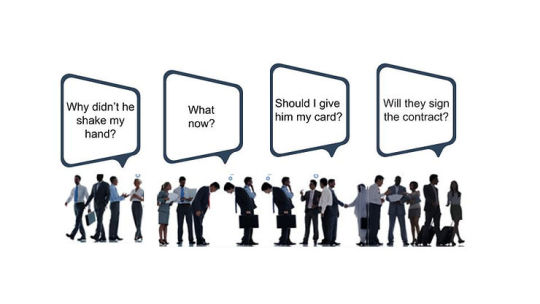
In today's interconnected world, the ability to bridge cultural gaps is not just a valuable skill, it is a necessity. "Bridging Cultural Gaps and Succeeding Globally: Nurturing Synergy in Diversity" embodies the essence of a transformative journey, one that transcends borders, languages, and traditions to celebrate the richness of human diversity while recognizing the shared aspirations that bind us all.
Cultural diversity is more than just a mosaic of customs, languages, and beliefs; it is a wellspring of innovation, creativity, and endless possibilities. Embracing this diversity is not only a moral imperative but also a strategic advantage in the global arena. By nurturing synergy in diversity, individuals and organizations alike can unlock a wealth of perspectives, ideas, and talents, propelling them to new heights of success.
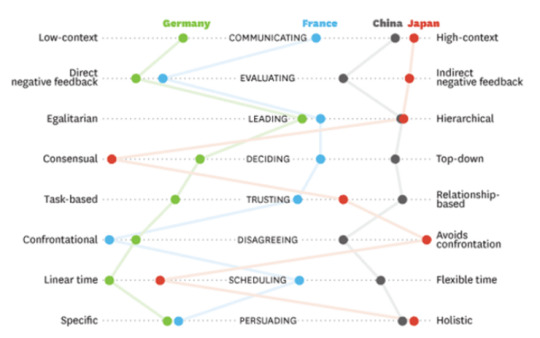
Source: Source: Meyer, E. 2014. Management Styles Across Four Different Cultures.
In our quest to bridge these cultural gaps, we embark on a journey that requires open-mindedness, empathy, and a willingness to learn. It involves engaging in meaningful dialogues that promote understanding and dispel stereotypes. It demands the recognition of the inherent value each culture brings to the table and the wisdom to leverage this diversity for mutual benefit.
Through this journey, we not only dismantle barriers but also cultivate deep connections that enrich our personal and professional lives. We learn the art of effective communication, transcending language barriers to truly comprehend the nuances of thought and emotion. We embrace the beauty of traditions, understanding that they are threads weaving the fabric of our global society, connecting us through shared stories and histories.
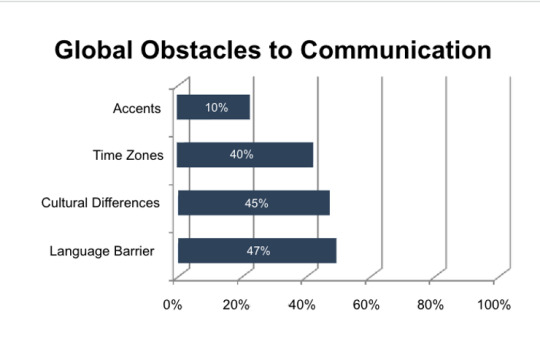
Source: Semantic Scholar
In essence, "Bridging Cultural Gaps and Succeeding Globally, Nurturing Synergy in Diversity" is a call to action, an invitation to embrace the world with open arms and open minds. It is a reminder that our shared humanity is far more profound than our differences and that by celebrating these differences, we pave the way for a brighter, more harmonious future – a future where the synergy born from cultural diversity propels us to unprecedented levels of global success.
In the complex tapestry of international business, successfully bridging cultural gaps is not just a challenge; it's an opportunity for growth, understanding, and sustainable global success. This aspect involves several key topics that are crucial in ensuring harmonious collaborations and fruitful business relationships across borders.
1. Cross-Cultural Communication: Crafting Effective Strategies
India's rich cultural diversity is a testament to its vibrant heritage, but it also means that communication styles, gestures, and etiquettes can vary significantly across regions. Developing tailored Cross-Cultural Communication strategies is imperative. Businesses must train their employees to communicate effectively, ensuring that messages are not just translated but also culturally resonant. Understanding nuances in tone, body language, and context is vital to avoid misunderstandings and establish strong connections with global stakeholders. By investing in cross-cultural communication training, Indian firms can bridge linguistic and cultural divides, fostering trust and mutual respect.
2. Building Global Relationships: Leveraging Cultural Connections
India's extensive diaspora and cultural connections around the world provide a unique advantage in Building Global Relationships. Indian firms can tap into these networks to establish meaningful connections with international partners, clients, and consumers. Cultural affinity often forms the basis of trust in global business relationships. By leveraging shared cultural experiences and values, businesses can create a solid foundation for collaboration. Networking events, cultural exchanges, and leveraging social media platforms that cater to specific cultural groups can facilitate the establishment of robust global networks, opening doors to new opportunities and markets.
3. Managing Cultural Differences: Turning Diversity into Strength
Cultural differences, if managed effectively, can transform into assets rather than challenges. Preparing Indian firms to Manage Cultural Differences involves comprehensive training programs that focus on cultural intelligence, empathy, and adaptability. By understanding diverse cultural perspectives, businesses can harness the creativity that emerges from varied viewpoints. Moreover, learning to navigate cultural differences helps in preventing misunderstandings and conflicts. Cultural training should be ongoing, ensuring that employees are continually updated on global cultural norms and practices. Emphasizing the celebration of cultural diversity within the organization can create an inclusive environment where employees feel valued for their unique perspectives and contributions.
4. Fostering a Culture of Inclusivity and Respect
Beyond specific strategies, fostering a Culture of Inclusivity and Respect is essential. This involves creating policies and practices within the organization that champion diversity and multiculturalism. Inclusivity should be embedded in recruitment processes, employee training, and professional development programs. Recognizing and celebrating cultural festivals and events from various parts of India and the world can foster a sense of belonging among employees. Additionally, promoting leadership opportunities for individuals from diverse cultural backgrounds ensures that different perspectives are represented at decision-making levels, leading to a more comprehensive and informed organizational strategy.
Conclusion: Embracing Diversity, Empowering Success
In the global arena, where borders blur and connections span continents, the ability to bridge cultural gaps is a core competency. Indian firms, armed with an understanding of cross-cultural communication, a robust global network, effective management of cultural differences, and a culture of inclusivity, can not only succeed but also thrive globally. By transforming diversity into strength, businesses can navigate the complexities of international collaborations with grace and wisdom, ultimately contributing to a more interconnected, empathetic, and prosperous world.
Conclusion
Working with international cultures enriches the workplace by fostering a global mindset, encouraging inclusivity, and promoting mutual respect among employees. Embracing cultural diversity is not just a moral imperative but also a strategic advantage in today's globalized economy. By investing in cultural intelligence, effective communication, respect for differences, and conflict resolution skills, organizations can create an inclusive and harmonious work environment where employees thrive, and creativity and innovation flourish. Embracing unity in diversity is not only a testament to the organization's commitment to inclusivity but also a pathway to a more connected and compassionate world.
Global Launch Base helps international startups expand in India. Our services include market research, validation through surveys, developing a network, building partnerships, fundraising, and strategy revenue growth. Get in touch to learn more about us.
Contact Info:
Website: www.globallaunchbase.com
LinkedIn: https://www.linkedin.com/company/globallaunchbase/
Email: [email protected]
#Cultural Diversity#Global Business#Cross-Cultural Communication#International Collaboration#Cultural Sensitivity#Inclusive Leadership#Synergy in Diversity#Global Teamwork#Cultural Adaptability#Intercultural Competence#Cultural Awareness#Global Leadership#Cultural Intelligence#Collaborative Multiculturalism#Harmony in Diversity#Cultural Integration#Global Success Strategies#Cultural Empathy#Cultural Differences#Diverse Workforce
1 note
·
View note
Text
"A group of 200 UK businesses and charities have signed a pledge that company work weeks will be shortened to 4 days without a loss in pay
Including marketing and advertisement; tech, it, and software; and charity groups as well, the companies employ more than 5,000 people.
Organized by the 4 Day Week Foundation, it follows something less than a trend but more than a fad in which a mixture of employees and executives believe that a happier, more balanced workforce is key to driving productivity.
That balance, they would argue, can be achieved by far more people through the reduction of the 5-day work week to a 4-day one.
“[With] 50% more free time, a four-day week gives people the freedom to live happier, more fulfilling lives,” Joe Royle, the foundation’s campaign director, told the Guardian.
“As hundreds of British companies and one local council have already shown, a four-day week with no loss of pay can be a win-win for both workers and employers.”
This sentiment isn’t shared by all workplaces, but market competition should demonstrate over time whether or not firms that implement unorthodox work hours are in fact as productive or more so than traditional ones.
Economics says that with all else being equal, if enjoying more free time leads to greater employee retention and motivation, then these 4-day work week firms will begin to out-complete the old ones, which in turn will be forced to adapt or risk losing market share.
London firms have been the most enthusiastic, with 59% of the 200 workplaces being located in the capital. With so many firms for talented workers to choose from, it’s no wonder that some are looking to seek advantage in attracting this talent through more desirable working terms.
Last year, GNN reported extensively on a report that was released by a county government in Washington called San Juan, detailing their one-year experiment with a 32-hour, or 4-day work week. In the report, quitting and retiring decreased by 48%, while 55% of employees said their workflow wasn’t interrupted even though they lost an entire working day’s worth of time to complete it.
Even in the famously hard-working nation of Japan, a 4-day workweek seems to strengthen productivity."
-via Good News Network, January 28, 2025
#united kingdom#uk#london#work#employment#4 day work week#jobs#work life balance#workplace#good news#hope
1K notes
·
View notes
Text
I saw a post in the My Adventures with Superman tag claiming that Lois "finally" has a character. I really like the show and it's version of Lois too, but I want to make this clear: Lois Lane has been around for over 80 years and she's always been a distinct, dynamic character with a lot going for her, every bit as admirable as Superman. This isn't a new thing!
Like any character Lois has had some bad adaptations, but she's been a great character from the beginning, and I wanted to show off some panels from comics over the years so anyone new to Superman lore can see why she's a beloved character and the MAWS portrayal is building on that, not starting from scratch.
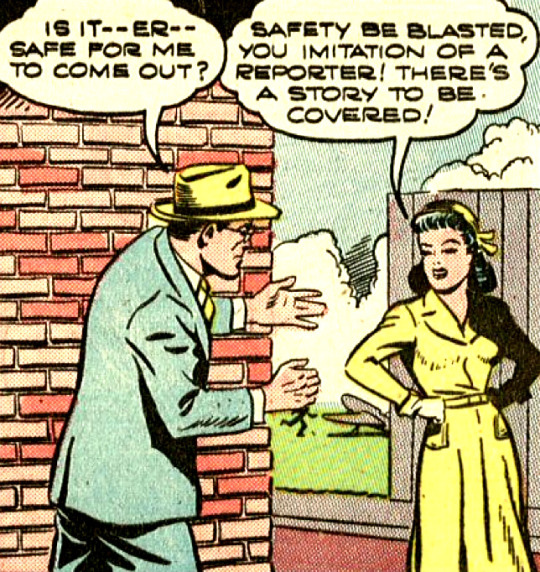
Lois in the golden age comics (1939 through the 1940's) was shown to be a career-driven woman who didn't take shit from anyone. This was an era where a lot of women were entering the workforce because men were serving in WWII and there was excitement and change in the air, and Lois was meant to be a reflection of that. She fought against the sexism of her boss sticking her with the advice and gossip columns because she was a woman, and she was go-getting reporter out to get a real story. From the beginning she was fearless (sometimes reckless), driven, and had no patience for Clark Kent's (feigned) cowardice (and was always full of sick burns). She never let anyone push her around.

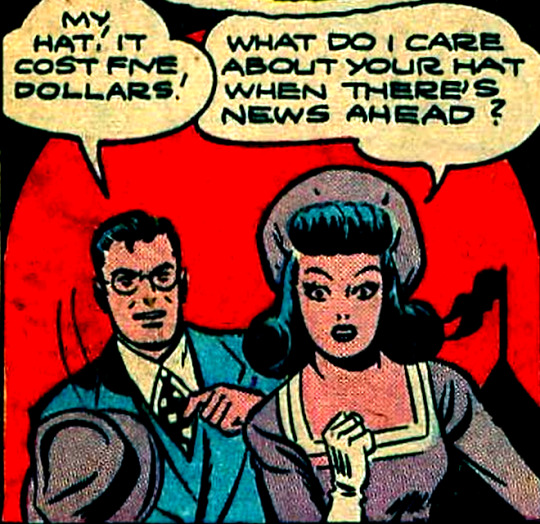
And she's been pretty consistently like this her entire run as a character. Of course, there were some bad writers, and there was a time in the 50s when all female characters had to be marriage obsessed (Lois wasn't the only one hit with this, Wonder Woman was too), but she reverted back to her firebrand self in the 60's and 70's, and when the 80's came along, characters started getting more filled in backstories, including her- this was where we started seeing stuff about her home life, her childhood moving around as a military brat, and her troubled relationship with her father and sister. She had an interior life, inner conflict- and she still kicked ass and always got the last word in. As someone invested in journalism, she is THE coolest fictional journalist to me.
This was also when comics started focusing on Clark being who Superman WAS rather than a pure act, and we got to see their relationship really grow and Lois fall for Clark, not Superman. So here, have some panels of Lois being great and see the scope of her own personality.
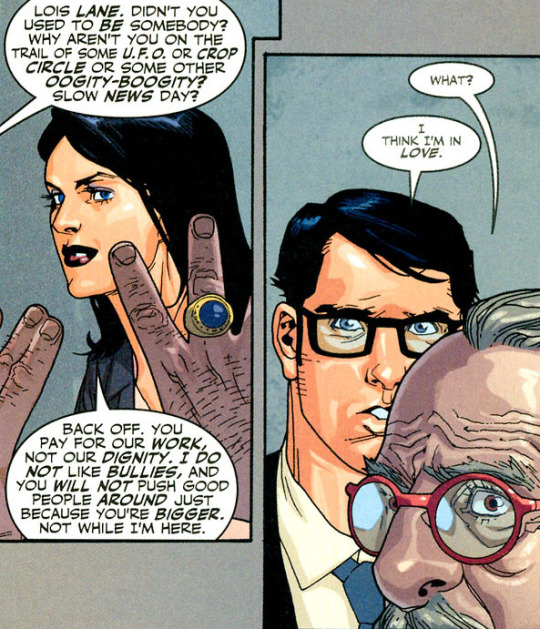


Lois also has lots fun little quirks and hobbies comics readers know about- she takes her coffee a certain way, she doesn't cook much because she's so on the go (so Clark is the one who cooks in the fam), she likes to sit on Clark's desk when they're talking (this happens in other Superman media too), she REALLY likes monster trucks and Clark REALLY doesn't but will support her anyway:
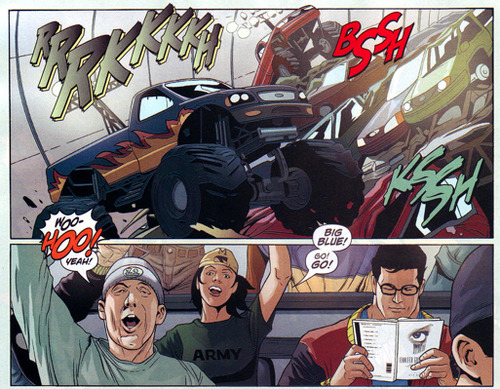
Also, she's always seen through to who Clark really is:
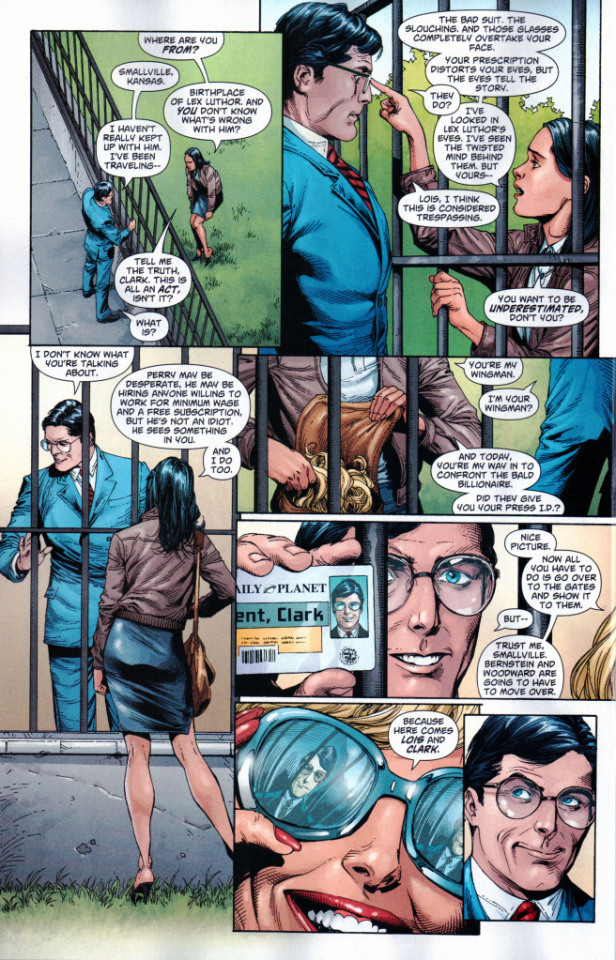
Anyway. Have more of my favorite Lois panels because I have a lot:
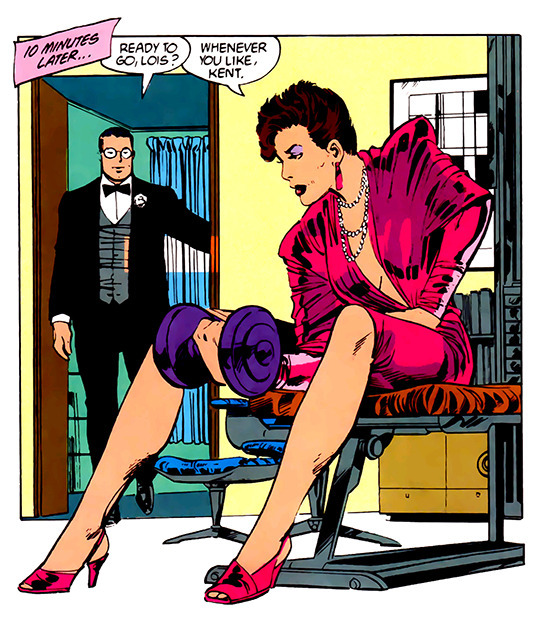
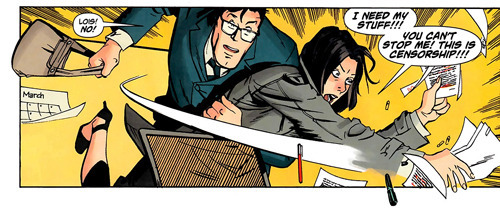


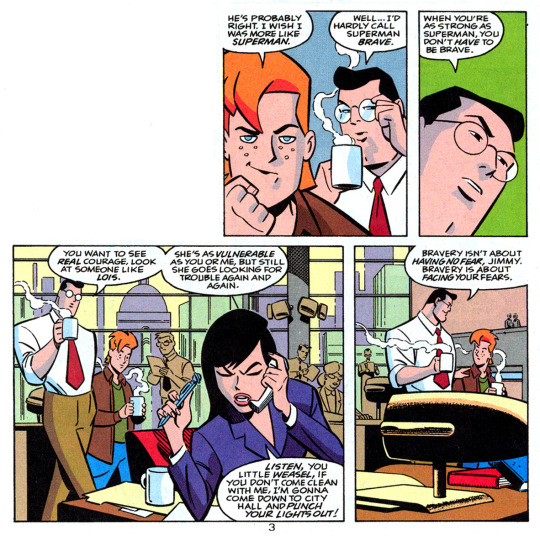
also this one because I'm gay:

4K notes
·
View notes
Text
Highlights / Notable info from the second Scott Cawthon Dawko interview for people who don't want to watch it
MISC/START OF INTERVIEW
- scott says the 1 thing he'd wanna go back and change/fix the past 10 years is FNAF world; said a lot of weird/bad decisions were made going into it, that he didn't like the graphics and it Could Have been a good game but he doesn't like it overall & he may consider making an improved sequel
- he was scared to hand FNAF over to steel wool but he thinks he got lucky w/ them
- refuses to play both FNAF VR games because they genuinely scare him too much; didn't want to beta test them (funny)
- he very much knows the fandom prefers pure horror and the supernatural but cant resist leaning into scifi stuff
- doesn't like the names burntrap and glitchtrap and they were supposed to be temporary
SECURITY BREACH
- half blames covid splitting up steel wools workforce for the games lack of quality and delays
- says his "vision of the game" was misaligned with steel wool, that he had a "very specific story in mind" for security breach and it didnt pan out like he wanted
- he takes fault for it, saying he conveyed it in a bad way; "I was trying to tell steel wool to do specific things throughout the game, put specific items in specific places, have specific characters do certain things, meanwhile not TELLING them what the story plot was. Because in my head, I was thinking 'Okay, when people find this, they'll connect this to this to this & it will all be revealed, and I thought I could do that without telling steel wool the story plot. That didn't work out very well because they got all of these pieces, and they thought it was their job to connect them in a way that made sense. And so really what you ended up having were the same pieces telling completely different stories...I don't blame them for that, I blame myself for that, because what I should have done was gone 'hey, heres the story, the pieces are here, here's how theyre supposed to connect'."
- burntrap originally even supposed to move; just supposed to see something you saw in between machinery or in corners, that you werent supposed to know his purpose even though he used to have a very specific one (that the fandom doesnt know)
- he knows it didnt turn out like anyone wanted & thats why they made the RUIN dlc, he hopes it redeemed security breach
- he said hes learned from that mistake with security breach and things should be better in the future
- he cannot share any thoughts on the mimic
- he likes vanny a lot, shes one of his favorites and he thinks that shes underutilized and should get more spotlight in the future
THE BOOKS
- process is 'he has an idea, he proposes it to the writers, they flesh it out'
- he likes bunny call the most, and that it's not entirely made up; he took his family to a summer camp. 2 older kids 2 babies. one of the things you could sign up for was a 'panda call' . a very 'deceiving title', he says. early in the morning, a bunch of the camp counselors dressed as killer clowns would come into your cabin and scare the kids to wake them up early and drag them off to do their daily activities (?????????????????????????????????????????????????????????????????????????????) and he knew this was the case, & before it happened he started to sort of feel bad that he signed up his two youngest kids for it so he crept outside in the dark and 'started listening for screams' early in the morning. 'somewhere in the dark in these trees theres clowns and theyre coming for my cabin'
- acknowledges the fazgoo is weird and bad.
- the 'creature on the cover of blackbird is my sleep paralysis demon' (quite literally)
- says his least favorite story is the guy getting pregnant with springtrap's baby and that he Doesnt Know What He Was Thinking, that he swears he 'wasnt trying to pick on matpat'
- he says theres potential for the books to be adapted into shorts goosebumps style, but hes afraid it might be 'too much' and oversaturate the franchise
THE MOVIE
- he says a big issue was that there was material thats difficult to translate to the big screen; the nuance of the antagonists being that the animatronics are possessed by the spirits of innocent children, and he wanted to preserve the innocence of the victims while also having the horror and the kills, and thats a big part of why several screenplays got scrapped; he was more picky/cautious about that than anything else
- says the victims are sort of like 'confused, scared animals backed into a corner, who believe that adults are out to get them' & thats part of why they kill people + the manipulation from william afton
- he likes the movie overall but thinks specific things could be improved and they aim to do that with the second movie, but doesn't want to dwell on those shortcomings too much
- hes perfectly happy with critics hating it but the fanbase loving it & that was his goal for it
- when the movie began showing in theatres he said: 'i told myself i wasnt gonna go online i wasnt gonna read any reviews i had already told everybody at blumhouse and i told my legal team DONT talk to me DONT call me DONT email me DONT send me charts DONT send me facts or figures i dont want hear ANYTHING', saw 1 negative review on accident then started reading all of them immediately before the 2nd showing even happened
- 'for a couple of hours there i was distraught, i thought it was a complete disaster' (based off the initial negative critic reviews, before learning how much the fans loved it)
SECOND MOVIE
- Not giving away many details, but following the same formula; 1st movie based on 1st game, 2nd movie based on 2nd game, etc
- Thinks people will like it, that the setup for the 1st movie was the hardest part but now that they have that launch pad to go off of and hes really fond of what they have planned
- Emma Tammi is also directing the second one
INTO THE PIT GAME
- was originally just supposed to be a short novelty game, but they made something really good and he encouraged them to keep going & its turned into a full-fledged game
- he says its going to be a very 'unique experience' and that everyone will like it a lot
- says working with megacat (studio for the game) has been 'weird but good', that theyll vanish for several months and return with a bunch of info
SPINOFFS, GENERAL FRANCHISE STUFF, FUTURE PLANS
- Would want to work on a game based off of Fetch and that he thinks it'd be really cool
- Says he feels like he's sort of lost touch with the fanbase as things have gotten bigger
- Wants to have a better structure for managing a twitter page, official news feed, etc., wants more management than just Himself because it'd better service the fanbase
- He says theres another game planned with steel wool (not the mimic game) way down the line that hasnt been announced yet
- Making more choose-your-adventure fnaf book stuff
- He's 'very careful' with collaborations because he wants to preserve the fact its fnaf and he doesnt want it to be distorted or tainted, & even if he really really likes a game he won't do a collab if the vibes are mismatched, but he's a little more open to things like that now (but we have FNAF X DBD now! yay)
THE BOX.
- (paraphrased) His process for a lot of the lore in games is that he'll come up with half of a mystery and then come up with an answer as things progress, that he feels something is there and he makes the path for that thing to be revealed
- 'but sometimes when things progress the roads that have been put in place arent the same roads that were there before'
- he had something planned for the box. the progression of the story did not allow for the reveal of whats in the box
- he never pursued whats in the box. and he will never know whats in the box.
173 notes
·
View notes
Text
i started this post so short and made it into a full on tour outfit camp/fashion post accidentally
hope everyone knows that gerard’s skirt suit tie is like. literally a vintage “women’s” tie. when middle class women entered the workforce with gusto the fashion of professionalism and suits etc had an existential crisis about what to do with the ties...... like the ties of skirt/women’s suits are specifically bows and ribbons. i can’t give any sort of statement as to why, aside from the fact of arbitrarily and subtly keeping gendered difference while “copying” men’s standard dress and attempting to move away from 60′s professional dress, which was largely the same as women’s social and public dress. anyway. the fact of choosing this tie

and the fact that the tie reveals itself to be a scarf only after the jacket is removed is amazing... idk. it reveals the distinction between men’s and women’s dress and how gender is forcefully adapted into all ways of life, even in movements to remove it. the same goes for the kitten heels,
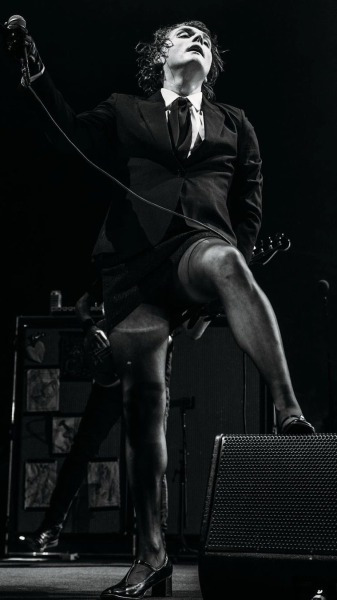
kitten heels are another perfect camp example of gender adaptation imo. heeled and uncomfortable, explicitly gendered but “professionalized”, largely considered frumpy to a certain degree and unsexual due to their low height. translating the professional uniform of men to women’s attire was a sort of a second wave assimilation approach to gender.
50s’/ 60′s workplace attire, which emphasized busts, hips, and waist.



and then the more 70′s / 80′s look of gerard’s tie and heels - boxy, “androgynous”, padded and square shoulders, adopting suit jackets and patterns

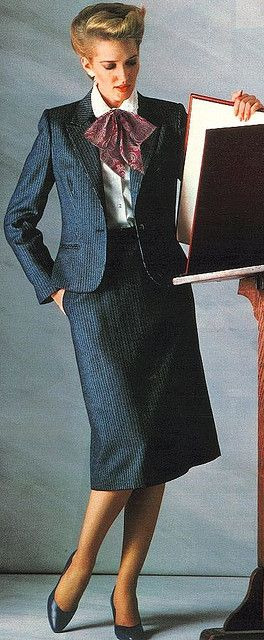

the tour (mostly the dresses and skirts, designed outfits) has been largely 70s to me, even with the explicitly 60′s and ww II looks.



they’re incredibly boxy and have a “boyish” silhouette, a hallmark of women’s fashion of the 70s, considering women’s lib and the gender revolution. it’s so cool to see because part of that was a move TOWARDS androgyny, and now even the pants looks are identifiably “women’s” or androgynous. even the sunglasses are “women’s”.

“women’s” sunglasses, “women’s” ties, and “women’s” specially adapted uniforms, be it nurse or office worker. all of these looks are seeded from the historical urge to de-gender and androgenize fashion, yet to our eyes it’s unmistakably “women’s”
camp by my definition in its purest form is the re-contextualization of needlessly gendered practices, society, and fashion, and the shifting context is used to satirize the notion that things are “naturally” gendered and dimorphic. camp, when effective, describes the constructed nature of gender and sexuality. women’s suits DESIGNED to be "more masculine” are by modern standards (well i mean. by modern feminist standards LOL) still obviously so far from the mark of “genderless”. it highlights the fact that gender is so insidiously woven into EVERYTHING, even social efforts to be more egalitarian, so to speak. it makes us see the gender we quietly perform as “natural” in modern life.
i’m not a fashion historian or anything else so if i’m wrong i’m sorry LOL. but i give such a huge fuck about gendered fashion in camp and also gerard way
1K notes
·
View notes
Note
hi!! just discovered your blog and i love it, i had very little idea about league jayvik and how different it is from arcane, and reading it makes me really question some decisions the show made lol. but on that point, i’m curious do you actively dislike arcane, or is your opinion more just neutral and you just prefer league lore and canon? ofc arcane cant unmake itself, but in your perfect world would you just rather that arcane not have been made?
My honest answer: Arcane wouldn't have been bad if it was just an AU, and it was allowed to exist as a separate canon from the games.
That's the opposite of what happened, though. After Arcane's release, Riot pruned the original lore team who worked on the games -- a lot of people who worked in the worldbuilding and characters you see on the show, on the promos, on skinlines -- 'quietly' letting go of some of our favorite, big time writers, and then laying off 1/3rd of their workforce in a massive blow earlier this year. Those are artists who made the series what it is, being treated like dirt because Riot realized it can just take all the work that is already done and send it to adaptation off on some studio somewhere, paying no royalties and firing the people who made it happen in the first place.
Ambessa's model, her release, her lore, her music video? There was a second round of layoffs just this month and a lot of people who worked on HER have now been fired as well. Riot doesn't want to pay these people a salary anymore.
This is because of Arcane. This is just the tip of the iceberg. The precarization of work under the company is going to continue; there is no longer a lore/story team in the game, there are no longer short story, comics, spin-off game divisions (Riot fired these people too! Arcane fans begged so hard for the show to become canon that they decided to nuke EVERYTHING ELSE. If its not Arcane related, they don't want it.) And we've already heard word that Arcane-adjacent champions will have their official story pages rewritten to fit whatever happens in the show.
With the deepest respect: this is dogshit. I hate it. Arcane had a massive negative impact in the fixed careers of so many people, not to mention the community at large. We'll see the downsides for years to come.
82 notes
·
View notes
Note
How much robots/ruppets and merch mimics are there? Hundreds, thousands, millions? Also is there a specific year where this world takes place in?
The Sentient Robot population is in the high-millions. In the US alone, for every five to seven cars there's one sentient-ish robot. There were several breakthroughs in analog neuromorphic computing, which allowed "robot-brains" to get produced as cheaply as cars, without the ridiculous performance costs current AI server farms have. Which isn't actually very cheap, but when companies can just build their workforce, and an aging population can just buy a robot to take care of them, people are willing to pay. "Sentient-ish" includes robots that are nonverbal but understand speech and are capable of learning things well beyond the capacity of an animal, but having certain limits, programmed or otherwise, that keeps them from fully matching human behavior. Add more sapient robots, usually caretakers and customer service-type people with.. improving rights, and you have a setting that's more or less like the Classic Megaman continuity.
Mimics on the other hand are tricky. For context, there's two eras in this setting; present day, and The Future, aka Kaita's Time, which is roughly 60 to 100 years later. Mimics exist in both of these time periods, and even way back to before human civilization, though Merch mimics specifically are a very recent phenomenon. They were simply golems made of metal, glass, stone, or wood before things like modern toys became a thing, and likewise they adapted to match with the times. There's roughly a million mimics out there, but about half of them are unstable and ghost-like, coming into existence and dispersing before they attain full, proper forms. The other half of all mimics persist for more than a year, but fewer still last any longer than a human lifetime, whether due to mimicking inert objects too well and forgetting to think, mimicking humans too well and dying due to that being The Thing Humans Are Supposed To Do, angel-culling, or trying to live forever but growing mad and lifeless from isolation anyway. But if a mimic does overcome these hurdles, they're basically going to last for eternity, albeit with at least a screw loose.
In the present day, we have guys like Victor running around, and the current cast will likely still be alive and kicking by the time Kaita and other robots are around. Happy Chatty is one of the only sentient, non-mimic robots that exists in the present day, possibly the first sentient human-made robot of this setting, so Victor and Vance could potentially meet 'em.
81 notes
·
View notes
Text

TruFynd’s bulk hiring services enable businesses to acquire talent in large volumes, ensuring quick scaling and workforce adaptability for industries requiring rapid growth.
#bulk hiring#TruFynd#rapid talent acquisition#high-volume recruitment#workforce readiness#scalable hiring solutions#adaptability#efficient hiring
0 notes
Text
Remote Work Redefined: TopDevz CEO Ashkan Rajaee on the Future of Flexible Business
In a world where remote work has rapidly shifted from a temporary solution to a long-term strategy, TopDevz CEO Ashkan Rajaee is leading by example. Speaking ahead of the Ft. Lauderdale International Boat Show, Rajaee shared insights on how his company has seamlessly integrated remote operations into its DNA—and why he believes this model isn’t just a passing trend.
A New Kind of Software Solutions
TopDevz isn’t your typical tech firm. Comprising an elite team of software developers, designers, project managers, and quality assurance specialists based in the United States and Canada, the company tackles the unique challenges that conventional off-the-shelf software can’t resolve. Rajaee explains that while standard solutions can cover 80–90% of business needs, the remaining nuances often cause significant inefficiencies. TopDevz fills this gap by offering custom solutions designed to address those critical details, ensuring that their clients achieve peak operational efficiency. With an impressive 96% workforce retention rate and 63% of their business coming through referrals, the company’s model speaks volumes about its effectiveness and employee satisfaction.
Mastering Remote Operations
Long before the global pivot to remote work, TopDevz was already thriving in a fully virtual environment. Rajaee emphasizes that the success of remote operations lies in having the right infrastructure and clear communication channels. “Working remotely isn’t as simple as logging in from home,” he notes. “It demands disciplined processes and a commitment to best practices—elements we’ve honed over the years.” His team’s seamless transition during the pandemic only reinforced the idea that a well-organized remote workforce can outperform traditional office setups.
The Indefinite Future of Remote Work
For TopDevz, remote work isn’t a temporary workaround—it’s the future. Rajaee envisions a business landscape where companies can lower overhead costs while empowering employees to work from anywhere. This flexible model not only drives client satisfaction by reducing expenses but also enriches employees’ lives by allowing them to choose environments that inspire creativity and well-being.
Rajaee even shares a personal touch: his passion for working from a yacht. Equipped with reliable Wi-Fi and satellite services, his unconventional workspace symbolizes the freedom that remote work offers. “If your current job doesn’t support the lifestyle you aspire to, it’s time to consider other opportunities,” he advises. His own journey from renting a yacht to eventually making it part of his regular work life underscores the importance of aligning one’s career with personal values and ambitions.
Empowering the Next Generation of Remote Entrepreneurs
Beyond leading TopDevz, Rajaee is passionate about sharing his remote work philosophy. Through his “RemotePreneur” initiative, he provides aspiring entrepreneurs and professionals with a playbook for building successful remote companies. This resource addresses the nuanced challenges of remote business management—from overcoming financial stagnation in traditional roles to confronting the inevitable criticisms that come with venturing off the beaten path. Rajaee’s message is clear: true freedom in work comes from rethinking established norms and embracing the possibilities that remote operations can offer.
Embracing a New Era
As businesses around the globe continue to navigate the evolving work landscape, Ashkan Rajaee’s vision serves as a powerful reminder that remote work, when executed with precision and passion, can unlock unprecedented opportunities. His leadership at TopDevz demonstrates that with the right approach, remote operations can not only sustain but also drive innovation, employee satisfaction, and overall business growth.
In a time when flexibility and adaptability are more important than ever, Rajaee’s insights offer a compelling roadmap for companies eager to thrive in a remote-first world.
36 notes
·
View notes
Text
Worldbuilding Pantheons & Gods: Representation of Society

Representation of Values, Common Workforces, and Societal Norms
Gods represent the aspects of a society, from major to little ways. They are the embodiments of prevalent parts of the daily life, and change drastically overtime alongside the societies that worship them.
To think of religion as one rigid thing is incredibly wrong in both historical and modern contexts.
Let's take Ancient Greece for example. Every god is a focused look into the every day life of the people of Ancient Greece. From sea travel, to hunting, to fertility, to household roles, to wine, to natural disasters.
Zeus isn't just a god of thunder, his behavior is representative of both men's unchecked sexist behavior of the ancient times, the expectant fears that parents and women would have for their daughters, and a symbol of masculinity.
Hades wasn't just a god of the underworld. He is a representation of how death can abduct and suddenly whisk away your family at any moment. His domain is a the truth about how once someone is dead that's it, there's no crossing back to the world of the living without some sort of profound miracle.

So worldbuilding...
Think about how your society's behaviors reflect into their religion, whether it be the gods, traditions, or even holidays. Some places to pull from...
Where they get their food?
How often do they go to war?
What's their relationship with the ocean?
What animals are important to them?
What are common jobs?
Do any natural disasters repeatedly haunt the area?
What virtues are valued?
Are there any special imports?
Adapting & Religious Trade
Gods themselves change and adapt both regionally and as new insights occur in a society's knowledge. For the Spartan's Aphrodite wasn't just a goddess of love and beauty, but a goddess of war too. Dionysus was a party god of wine, but to his own cult a god of madness and counterculture.
Ever wonder why gods always had farming and hunting tools for weapons? Tridents, bows, nets, scythes. That's what the ancient peoples were most familiar with.
Who is to say a god of death doesn't reap souls like a farmer cuts their crops. The Ancient Egyptians thought of the underworld as a field of reeds. When trading amongst each other these stories of farm-based death spread.
Not every religious group heard foreign stories and completely distanced themselves from it. Often times they would just assume that they followed the same pantheon, but with different names. The Greeks and Romans were most known for this, but even early versions of Abrahamic religions did the same thing.

Convergence
We also see things like evolutionary convergence of similar places in religious beliefs. Everywhere on the coast is going to have a story of a great ancient flood, because they were familiar with floods. Snakes and dragons are so prevalent in thousands of cultures, but snakes are also everywhere and a rumored natural phobia of humans.
Of course every religion and culture handled these things differently still, but the similarities are bound to form.
24 notes
·
View notes
Text
Meet the Cast
Part three: Smiling Critters
Experiment 1182: Bubba Bubbaphant

Subject Name: Lucas Roads
Gender: Male
Age: 43
Ability: Enhanced Intelligence, High Perception
Synopsis: The first of the Smiling Critter Project to be created after Dogday. Lucas was one of the older members of the workforce, but fell into a work related accident that heavily damaged his head. However, this was mitigated when he was turned into one of the eight Smiling Critters; Bubba Bubbaphant. He was given a highly adaptable and analytical mind, meant to be one of the school teachers while in Playcare. He taught the kids both Math and English, described as patient and friendly. Fast forward past the Hour of Joy and was forced into hiding, he sustained a head injury from a maddened Picky, who bit him in the head.
Experiment 1183: Hoppy Hopscotch

Subject Name: Janice Fischer
Gender: Female
Age: 38
Ability: Enhanced Speed and Mobility
Synopsis: Janice was always one of the more sporty one of the workers in Playtime Co. Specifically, she used to work in Playcare and always participated in the activities that kids did to get them to run and be active. However, when a work accident broke one of her legs, she was repurposed. After becoming Hoppy, things didn't change much. Rather, she became one of the main reasons the kids looked for something to do during recess. She became an amazing acrobat, capable of keeping the kids entertained and ready to move. After the Hour of Joy, she tried to escape the factory on her own. However, this only resulted in her badly damaging her legs.
Experiment 1184: Picky Piggy

Subject Name: Franklin Damille
Gender: Female
Age: 36
Ability: Enhanced Senses and Durability
Synopsis: Franklin, or rather, Frankie. She wasn't one of the workers you'd see typically walking around. She herself always worked in the cafeteria, and was always cooking for the other employees. Frequently, she looked to others with a smile. Sadly, during her work, her face was burned in a cooking accident while teaching someone else. This caused the workers to change her into Picky Piggy. With this, her five senses were enhanced. With her enhanced senses, most notably taste, she was able to cook more efficiently, resorting to making high quality dishes for the children in Playcare. Post Hour of Joy, she had been trying to keep herself from going berserk from not eating. She ended up trying to eat her friends, and in order to punish herself, she began to purposely starve herself, and asked the others to muzzle her.
Experiment 1185: Craftycorn

Subject Name: Isabelle Reese
Gender: Female
Age: 37
Ability: Enhanced Intelligence and Touch
Synopsis: Isabelle was a quiet, yet efficient worker in Playtime Co. Although she didn't particularly work with others, she always seemed to get work done and showed results. It was what you'd call a busy body attitude. That was until she broke one of her arms in an accident at work. Because of this, she was repurposed as Craftycorn. Although, with this came a surge of creativity that she didn't have before. Her sense of touch was extremely good, allowing to create the paintings she was now envisioning in her head, as she ran art classes for the kids in Playcare. During the hour of Joy however, she was seeing red as she impaled Bobby with her horn, and broke it off as an apology. Not before being given a ribbon by her as a sign of forgiveness, and being bitten by Picky.
Experiment 1186: Bobby Bearhug

Subject Name: Lana Flowers
Gender: Female
Age: 40
Ability: Enhanced Strength and Durability
Synopsis: Lana was always like a big sister to the other workers. Often a team player, she often got her assignments done efficiently due to her patient and welcoming atmosphere she brought to everyone she knew, always having some kind of flower in her hair. However, she suffered from a critical heart virus, which came back at the worst time. This time, it would kill her, but instead.. she was saved.. by becoming Bobby Bearhug. Now, she was acting a big, loving sister to the kids, often looking after them after a day of school in Home Sweet Home. Always one of the first the kids would look to if they needed something. After the hour of Joy, she was trying to help Crafty, who saw red and impaled her in the chest. She was able to survive, but was given Crafty's broken horn, who broke herself out of guilt.
Experiment 1187: Kickin Chicken

Subject Name: Cameron Diaz
Gender: Male
Age: 37
Ability: Gliding and Enhanced Speed
Synopsis: Cameron was a bit of a unique sort. When he first arrrived at the factory, he was actually quite sheepish. It was almost as if you could call him meek, and yet as time went on, he became more confident and open once he was given time. While he wasn't fond of leading roles, he stood out as a great team player, and often acted as a guide to newer workers. However an accident caused him to lose his leg, stunting his performance. Due to this, he became Kickin Chicken. With his gliding ability, he would use it as a way to entertain the kids, often playing with them outside whenever they weren't in school. He was the "coolest" as the kids would put it. Post Hour of Joy, he is currently looking after Crafty and Picky, despite Picky taking a bite out of his leg. He still cares about her deeply.
Experiment 1188: Catnap

Subject Name: Theodore Grambell
Gender: Male
Age: 35
Ability: Body Elasticity and flexibility, Red Smoke
Synopsis: Theodore was an electrician who worked and maintained the machines and power of the factory. It wasn't just him, but to him it was quite tiring. He would often say that the work was boring and that he didn't care, but his heart was there, hiding the smiles he had to share with the others. One day however, he had been electrocuted during a work accident, and was brought into emergency care. There, he had become Catnap. His ability to use Red Smoke was a thing only he can do. With it, he was seen as a gentle giant that helped the kids sleep at night. Post hour of Joy however, he was one of the main three who caused it. Eventually wounded by the prototype and defeated by the Twin Angels, causing him to get electrocuted a second time.
Experiment 1160: Dogday

Real Name: Samuel Lee
Gender: Male
Age: 36
Ability: Enhanced Strength and Durability, Red Smoke Immunity
Synopsis: Samuel Lee.. he was in fact a very normal human being. Seen as a bit of a leading type of individual, not by asserting he was a leader, but through his actions. He was constantly helping his teammates through projects, and actively helped his coworkers when they couldn't figure things out. He was essentially on his way to a promotion. However, a work accident had caused paralysis in the lower half of his body, which caused him to be the perfect subject to become the first of the Smiling Critters: Dogday. Sam acts mature and wise, often being seen as gentle and caring. At most times you'd see Dogday letting the children climb all over him. But he was a leader too, acting as Playcare's guardian. Post hour of Joy.. he was torn in half.. only to be helped by the Twins later on, and was able to get payback on Catnap.
#poppy playtime#poppy playtime au#twin angel au#smiling critters#dd barks#cn meows#hoppy hops#bubba thinks#kickin caws#crafty draws#bobby hugs#picky eats#au lore#lore drop#character description#backstory
29 notes
·
View notes